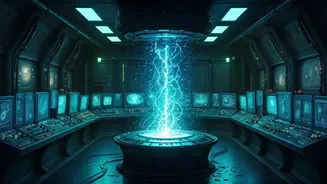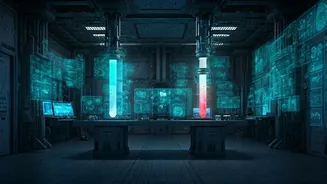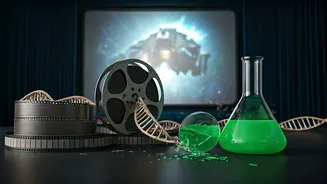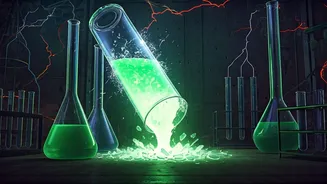Zero-G Explosions
One of the most frequent scientific inaccuracies in movies and TV is the depiction of explosions in space. In reality, explosions need air to propagate.
Therefore, a massive, fiery blast in the vacuum of space, like what is often seen, is impossible. Without any air or oxygen, the explosion's visual effects would be severely hampered, if visible at all. Yet, filmmakers consistently ignore this fact for dramatic effect. This is a common trope, used to create intense action sequences. Space battles in science fiction often involve explosions that defy the very laws of physics. For instance, the film 'Star Wars' shows incredible explosions, with fireballs and shockwaves, though they should appear differently. The lack of air means that explosions in space would not have the same shape or effect, a stark contrast to the dramatic visuals we are used to.
Sound in Space
Related to the explosion issue, another major scientific gaffe is the presence of sound in space. Sound waves require a medium, such as air, to travel. In the vacuum of space, there is no such medium, which means no sound can propagate. Yet, countless movies feature the roaring sounds of spacecraft, explosions, and laser fire. This is done to make the scenes more engaging for audiences accustomed to sound. The visuals are enhanced when matched with sound effects, adding to the spectacle. The 'Star Trek' franchise, known for its space battles, often has the dramatic 'whoosh' sounds of ships flying by, and the sound of phasers. These sounds, designed to amplify the action, completely contradict the scientific reality of space. The absence of sound would diminish the excitement, thus filmmakers choose dramatic license over scientific accuracy.
Rapid Time Travel
Movies and TV shows frequently toy with the concept of time travel, but often without any regard for the complexities of the subject. A common trope is instantaneous time travel. Characters suddenly appear in different time periods without any consideration of the energy requirements or the physics involved. The film 'Back to the Future' has many instances of instantaneous time travel. Time travel is a complex concept based on scientific theories such as relativity and spacetime. In reality, travelling through time might involve extreme energy expenditure and, according to current scientific understanding, might not even be possible. The depictions of time travel in popular media often disregard these factors to prioritize storytelling, creating narratives that are often engaging but scientifically questionable. The consequences, the physics, and the possibilities of time travel often take a back seat to the dramatic and visual presentation.
Instantaneous Acceleration
A common visual shortcut used in sci-fi is the instant acceleration and deceleration of spacecraft. Ships in movies often move at incredibly high speeds immediately. The problem is that such acceleration would crush any living being inside. The force involved would be fatal, not allowing humans to survive. Similarly, instant stops at high speeds would be equally devastating. In reality, achieving such speeds requires gradual acceleration to prevent the crew from experiencing harmful G-forces. This is because objects need time to reach high velocities gradually. Many films, like 'Star Wars', showcase ships accelerating to the speed of light in seconds. The effects team has to decide between realism and aesthetics. But in terms of accuracy, these depictions are far from reality. This allows for dramatic visuals, but it departs drastically from the physics of space travel. The visual spectacle triumphs over the constraints of reality.
Implausible Medical Tech
Many sci-fi shows introduce futuristic medical technology that surpasses what is scientifically feasible. This includes instant cures for diseases, miraculous healing, and the ability to revive the dead. These innovations help solve plotlines but they are often highly exaggerated. Real-life medicine has made significant strides, but it still has limitations. The idea of instant cures and perfect medical outcomes is almost always a product of science fiction. The writers and production crews often need to streamline plot points. The result can be exciting storytelling, but with an unrealistic depiction of how medicine functions. The technology presented is generally a far cry from the realities of modern medicine. They make for interesting plot devices, but are not based on any scientific facts. Such technology, while exciting, remains mostly in the realm of fiction.
Perpetual Motion Machines
The concept of perpetual motion is frequently misunderstood and misused. According to the laws of thermodynamics, it is impossible to create a machine that operates continuously without any energy input. Despite this, sci-fi is rife with devices that seem to defy these laws, often producing energy indefinitely. These devices are used to provide the setting for technological advancement or to explain the operation of advanced space-faring vessels. The concept is often employed to suggest an unlimited power source. The perpetual motion machine is a recurring theme that reflects an oversimplification of complex scientific concepts. It makes for compelling plots, but it ignores the fundamental principles that govern how energy works. The idea is to create a sense of advanced technology that doesn't necessarily follow any scientific norms.
Unrealistic Artificial Gravity
Creating artificial gravity is also a problem for filmmakers. In many science fiction settings, spaceships have artificial gravity that is often presented as readily available and easily controlled. The effect is used in the ship's internal layout. In reality, simulating gravity requires complex engineering. This could be done by creating centrifugal force through rotation. The lack of accurate portrayal enables the characters to function in environments with normal, Earth-like conditions. However, the exact mechanics are usually ignored for the purpose of the story, with gravity appearing without any explanation. This simplifies the visual representation of space travel. This is another area where the demands of storytelling and visual effects often clash with scientific accuracy.
Oversimplified Genetics
The field of genetics, with its complex interactions, is often simplified in film. The ability to instantly manipulate or alter DNA is often portrayed. Scientists can modify genes with ease in films. Real-life genetic engineering is a time-consuming and complicated process with numerous ethical considerations. The simplification is a narrative shortcut to explain character abilities, plot twists, or even monstrous transformations. Genetic mutations are often a quick fix in storylines, but they frequently overlook the intricate biological processes involved. Many movies and TV series use genetic engineering as a simple explanation. They skip over the hard science to create exciting plot developments. The complex reality of genetic processes is frequently overlooked in favor of creating narratives.
Misunderstood Lasers
Lasers, a staple of science fiction, are often depicted inaccurately. In many movies, laser beams are shown as visible rays of light with the ability to travel at a slow speed and even bend in various ways. These beams are designed to be seen. In reality, lasers are invisible and travel at the speed of light in a straight line. The laser effects are usually designed to be visually appealing. They are usually designed to create dramatic impact and enhance the aesthetics of the action. The laser depictions in many films and shows often disregard the physical properties of light. While the visible beams and slow speeds are entertaining, they are not based on any scientific facts. These incorrect visuals are used to increase the overall impact of the action sequences, but they are not based in reality.











